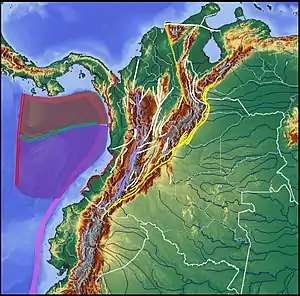1868 Ecuador earthquakes
The 1868 Ecuador earthquakes occurred at 19:30 UTC on August 15 and 06:30 UTC on 16 August 1868. They caused severe damage in the northeastern part of Ecuador and in southwestern Colombia. They had an estimated magnitude of 6.3 and 6.7 and together caused up to 70,000 casualties. The earthquake of 15 August occurred near El Ángel, Carchi Province, close to the border with Colombia, while that of August 16 occurred near Ibarra in Imbabura Province.[1] Reports of these earthquakes are often confused with the effects of the earthquake of 13 August at Arica.[2]
| UTC time | Doublet earthquake: |
|---|---|
| 1868-08-15 19:30 | |
| 1868-08-16 06:30 | |
| Local date | 15 and 16 August 1868 |
| Magnitude | |
| 6.3 Mw | |
| 6.7 Mw | |
| Depth | 20 km |
| Epicenter | 0.31°N 78.18°W |
| Areas affected | Ecuador, Colombia |
| Casualties | 70,000 |
Tectonic setting
The active tectonics of Ecuador is dominated by the effects of the subduction of the Nazca Plate beneath the South American Plate. The high degree of coupling across the plate boundary where the Carnegie Ridge is being subducted beneath northern Ecuador causes unusually intense intraplate deformation.[3] Known faults within the area of the earthquake epicenters are the SSW-NNE trending San Isidro, El Ángel, Río Ambi and Otavalo Faults, all considered to be dextral strike-slip faults, sometimes with reverse movement. All these faults are interpreted to have moved in the last 1.6 million years.[4]
Damage
Characteristics
There was a minor foreshock the previous afternoon (possibly the 15 August event),[2] with the mainshock occurring at 01:30 local time early on the morning of 16 August. The shaking lasted for one minute.[7]
Aftermath
The relief efforts were organised by Gabriel García Moreno, who had been appointed to that role by the federal government.[6]
On 26 April each year, in the 'El Retorno' festival, Ibarra celebrates the return of the inhabitants in 1872 after a four-year absence following the earthquake.[8]
See also
References
- Giesecke, A.; Capera A.A.G.; Leschiutta I.; Migliorini E. & Valverde L.R. (2004). "The CERESIS earthquake catalogue and database of the Andean Region: background, characteristics and examples of use" (PDF). Annals of Geophysics. 47 (2/3): 421–435. Retrieved 22 August 2010.
- NGDC. "Comments for the Significant Earthquake (16 August)". Retrieved 23 August 2010.
- Gutscher, M.-A.; Malavieille J.; Lallemand S. & Collot J.-Y. (1999). "Tectonic segmentation of the North Andean margin: impact of the Carnegie Ridge collision" (PDF). Earth and Planetary Science Letters. 168 (3–4): 255–270. Bibcode:1999E&PSL.168..255G. doi:10.1016/S0012-821X(99)00060-6. Retrieved 24 August 2010.
- USGS (2003). "Map of Quaternary Faults and Folds of Ecuador and Its Offshore Regions" (PDF). Open File Report OFR 03-289. Retrieved 23 August 2010.
- NGDC. "Comments for the Significant Earthquake (15 August)". Retrieved 23 August 2010.
- Henderson, P.V.N. (2008). Gabriel García Moreno and conservative state formation in the Andes. LLILAS new interpretations of Latin America series. University of Texas Press. pp. 134–141. ISBN 978-0-292-71903-3.
- Orton, J. (2008) [1870]. "X". The Andes and the Amazon. 124–134. BiblioBazaar, LLC. ISBN 978-0-554-29708-8.
- Kunstaetter, R.; Kunstaetter, D. (2007). Footprint Ecuador and Galápagos (6th ed.). Footprint Travel Guides. p. 180. ISBN 978-1-904777-93-9. Retrieved 20 August 2010.



